Unfortunately, some readers do not share our desire to discuss positive ways to reduce our impact on the planet. In order to keep this blog productive, I will turn comments off for a while. We're all here to have fun and share ideas. We don't all have to agree with the ideas. I certainly wouldn't insist on anyone flushing their dog's waste into the sewer system, and not everyone likes potatoes in their burritos or cucumber in their water.
I hope you will continue to read. I've certainly enjoyed learning about what other people and companies are doing to make the world a better place, and I hope you have too.
Friday, August 31, 2007
Friday Recipe - Mashed Potato Burritos
Mashed Potato Burritos
4 large potatoes, peeled (or not) and diced
6 large tortillas
1/4 to 1/3 cup milk
salsa
grated cheese
1. Preheat oven/toaster oven to 400F.
2. Cover potatoes with water in a saucepan. Bring to a simmer, cover,and simmer gently until tender, about 15 minutes.
3. Wrap the tortillas in foil and warm in the oven.
4. Combine drained potatoes and milk in a mixing bowl and mash well.
5. Divide mashed potatoes among the tortillas, spreading some down the center of each. Spread a little bit of salsa over the potatoes, and sprinkle with the optional cheese. Roll up snugly and enjoy.
(We skipped the oven and just used the microwave - save energy)
- The Vegetarian 5-Ingredient Gourmet
Bonus: Banana Pudding
Mash a banana in a freezable container and freeze overnight. Pack it in your lunchbox, and by lunchtime, you'll have banana pudding. Fun!
4 large potatoes, peeled (or not) and diced
6 large tortillas
1/4 to 1/3 cup milk
salsa
grated cheese
1. Preheat oven/toaster oven to 400F.
2. Cover potatoes with water in a saucepan. Bring to a simmer, cover,and simmer gently until tender, about 15 minutes.
3. Wrap the tortillas in foil and warm in the oven.
4. Combine drained potatoes and milk in a mixing bowl and mash well.
5. Divide mashed potatoes among the tortillas, spreading some down the center of each. Spread a little bit of salsa over the potatoes, and sprinkle with the optional cheese. Roll up snugly and enjoy.
(We skipped the oven and just used the microwave - save energy)
- The Vegetarian 5-Ingredient Gourmet
Bonus: Banana Pudding
Mash a banana in a freezable container and freeze overnight. Pack it in your lunchbox, and by lunchtime, you'll have banana pudding. Fun!
Thursday, August 30, 2007
More on pet waste... CATS
Cats
The best choice for cat waste is a natural kitty litter. There are many options - some made of pine chips, newspaper, corn, and wheat. Treehugger highlights Swheat Scoop as a good "green" litter, and readers share other options in the comments.
Clay litters are bad news all around because they must be strip-mined, which is bad for the environment, and it later ends up in the landfill. Plus, the dust is bad for kitty, and you.
Pets
Here are some other ways to "green" your pets. Some people are actually converting cow poop into energy, which can power an entire farm!
The best choice for cat waste is a natural kitty litter. There are many options - some made of pine chips, newspaper, corn, and wheat. Treehugger highlights Swheat Scoop as a good "green" litter, and readers share other options in the comments.
Clay litters are bad news all around because they must be strip-mined, which is bad for the environment, and it later ends up in the landfill. Plus, the dust is bad for kitty, and you.
Over 2 million tons of non-biodegradable cat litter made from clay that is mined ends up in municipal landfills each year.Thurston County, WA is concerned with pet waste, and gives suggestions for disposal. One suggestion is to flush dog and cat waste down the toilet. There has been some confusion about toxic cat waste, and whether flushing is a good solution. Do not flush if you buy clay litter. It must be flushable. If so, it is perfectly safe to flush. Some people even train their cats to use the toilet. The concern with cat waste is from feral cats who relieve themselves outside, which will seep into ground water and sewer water.
Pets
Here are some other ways to "green" your pets. Some people are actually converting cow poop into energy, which can power an entire farm!
By popular demand... a post on pet waste: DOGS
Dogs
Dog waste is hard to get rid of because the plastic bags aren't exactly biodegradable. Some say they are (here's one), but as I've learned, our landfills are designed in such a way that nothing really biodegrades. We walk our dog every day, and she usually dumps on the walk, but sometimes does it in the backyard, which is where a waste removal system would be most beneficial. There are a couple of ways to design a backyard dog waste remover: a Doggie Dooley, a home-made dog waste compost, or a flushing system.

The Doggie Dooley is a pre-built waste disposal system that you put in your backyard. You add enzymes to get the stuff to compost, and the rest is history. It seems pretty simple, and you don't have bad smell, bugs, or garden contamination.
 Visit the City Farmer.com for a step-by-step guide to making your own dog waste composter. All you really need is a garbage can and a shovel. Cut out the bottom of the garbage can, dig a deep hole, bury the garbage can, dump the poop inside, and cover with the garbage can lid. You can add enzymes to start the composting process. Since this method reaches the soil, make sure you bury it away from food gardens.
Visit the City Farmer.com for a step-by-step guide to making your own dog waste composter. All you really need is a garbage can and a shovel. Cut out the bottom of the garbage can, dig a deep hole, bury the garbage can, dump the poop inside, and cover with the garbage can lid. You can add enzymes to start the composting process. Since this method reaches the soil, make sure you bury it away from food gardens.
This site, Pet Habitats, designed a dog waste flusher that may work for you. It connects to the sewer line and uses your outside hose to flush the waste down, bags and all. They say it doesn't clog the pipes. Pet Habitats offers these environmental facts about their product.
I like the home-made composter and the Doggie Dooley. They're both good options for people who want an easy set-up and low cost. Pet Habitats attempts to meet the needs of dogs like mine, who "go" on walks instead of in the backyard. They are all interesting options for getting rid of your dog waste in a environmentally friendly way.
Dog waste is hard to get rid of because the plastic bags aren't exactly biodegradable. Some say they are (here's one), but as I've learned, our landfills are designed in such a way that nothing really biodegrades. We walk our dog every day, and she usually dumps on the walk, but sometimes does it in the backyard, which is where a waste removal system would be most beneficial. There are a couple of ways to design a backyard dog waste remover: a Doggie Dooley, a home-made dog waste compost, or a flushing system.

The Doggie Dooley is a pre-built waste disposal system that you put in your backyard. You add enzymes to get the stuff to compost, and the rest is history. It seems pretty simple, and you don't have bad smell, bugs, or garden contamination.
 Visit the City Farmer.com for a step-by-step guide to making your own dog waste composter. All you really need is a garbage can and a shovel. Cut out the bottom of the garbage can, dig a deep hole, bury the garbage can, dump the poop inside, and cover with the garbage can lid. You can add enzymes to start the composting process. Since this method reaches the soil, make sure you bury it away from food gardens.
Visit the City Farmer.com for a step-by-step guide to making your own dog waste composter. All you really need is a garbage can and a shovel. Cut out the bottom of the garbage can, dig a deep hole, bury the garbage can, dump the poop inside, and cover with the garbage can lid. You can add enzymes to start the composting process. Since this method reaches the soil, make sure you bury it away from food gardens.This site, Pet Habitats, designed a dog waste flusher that may work for you. It connects to the sewer line and uses your outside hose to flush the waste down, bags and all. They say it doesn't clog the pipes. Pet Habitats offers these environmental facts about their product.
I like the home-made composter and the Doggie Dooley. They're both good options for people who want an easy set-up and low cost. Pet Habitats attempts to meet the needs of dogs like mine, who "go" on walks instead of in the backyard. They are all interesting options for getting rid of your dog waste in a environmentally friendly way.
Wednesday, August 29, 2007
Guest Post on Fair Trade
This is a guest post from my husband, a high school social studies teacher. In his personal studies, he has become very interested in Fair Trade, and loves to share what he's learned.
What in the world is Fair Trade? In actuality, there is no concrete definition of Fair Trade. However, the term generally refers to the movement to ensure that producers in developing countries receive more of the benefits from products sold to consumers.
Companies certified by Fairtrade Labelling Organizations (FLO) ensure a minimum price for farmers, for example. The theory being that the “minimum wage” will help assist those struggling regions to develop into an economically productive region. As a side note, some products claiming to be fair trade might not dedicate themselves to a minimum price, thus allowing adjustments as they see fit.
The Fair Trade market might be small, but it is growing quickly (perhaps more quickly in Europe than America).
Advocates applaud Fair Trade’s pricing. By cutting out the middleman, Fair Trade seeks to relay more of the money back to the producer. In addition, producers learn about the market, trade and exporting. While advocates point to the possibility of Fair Trade’s assistance in eradicating poverty, critics claim Fair Trade’s weak impact, saying that Fair Trade helps a small few, while not really helping the big picture at all. Similarly, critics proclaim Fair Trade as counter-productive by delaying the inevitable—the need for developing nations to diversify their economies.
There definitely exist concrete pros and cons to Fair Trade. There is good reason to think its impact is too small. However, Fair Trade possesses one more unmistakable positive—the power to educate and enlighten. Sure, perhaps its impact is minimal. That’s for the individual consumer to decide. But the fact that Fair Trade is in stores and people are asking questions about Fair Trade creates a discussion.
The true concept behind Fair Trade is to build awareness about the poverty in the world. So maybe you hate Fair Trade and its coffee, teas, chocolates and clothes, but we can’t deny the fact that Fair Trade brings to light a greater question: What are we doing to assist the poor of the world?
What in the world is Fair Trade? In actuality, there is no concrete definition of Fair Trade. However, the term generally refers to the movement to ensure that producers in developing countries receive more of the benefits from products sold to consumers.
Companies certified by Fairtrade Labelling Organizations (FLO) ensure a minimum price for farmers, for example. The theory being that the “minimum wage” will help assist those struggling regions to develop into an economically productive region. As a side note, some products claiming to be fair trade might not dedicate themselves to a minimum price, thus allowing adjustments as they see fit.
The Fair Trade market might be small, but it is growing quickly (perhaps more quickly in Europe than America).
Advocates applaud Fair Trade’s pricing. By cutting out the middleman, Fair Trade seeks to relay more of the money back to the producer. In addition, producers learn about the market, trade and exporting. While advocates point to the possibility of Fair Trade’s assistance in eradicating poverty, critics claim Fair Trade’s weak impact, saying that Fair Trade helps a small few, while not really helping the big picture at all. Similarly, critics proclaim Fair Trade as counter-productive by delaying the inevitable—the need for developing nations to diversify their economies.
There definitely exist concrete pros and cons to Fair Trade. There is good reason to think its impact is too small. However, Fair Trade possesses one more unmistakable positive—the power to educate and enlighten. Sure, perhaps its impact is minimal. That’s for the individual consumer to decide. But the fact that Fair Trade is in stores and people are asking questions about Fair Trade creates a discussion.
The true concept behind Fair Trade is to build awareness about the poverty in the world. So maybe you hate Fair Trade and its coffee, teas, chocolates and clothes, but we can’t deny the fact that Fair Trade brings to light a greater question: What are we doing to assist the poor of the world?
Ohio Flooding
Please keep Ohioans in your thoughts as some regions recover from severe flooding and other thunderstorm damage. If you are able, you may consider donating to the Red Cross, who is helping flood survivors in Ohio. You may direct your gift to the Ohio Floods specifically.
Earlier this week, a string of severe thunderstorms caused significant flash floods, mudslides and dam breaks throughout Ohio. As families and individuals wade through deep waters towards shelter, the rains continue. Local chapters immediately opened shelters for the hundreds of people that had to evacuate their flooded homes. Over 700 Red Cross disaster workers are serving hot meals and snacks, as well as distributing clean up and comfort kits to affected residents. - Red Cross
Tuesday, August 28, 2007
Vinegar Cure-All
It's hard to find a good cleaning product that is safe for you, your children, pets, and the environment. Many products look and smell clean and pure, but you can never be too sure. And most are needlessly tested on animals. Here's one product you can use with confidence - vinegar!
Vinegar and water can be used with great success to clean just about anything (test a spot if you're nervous). Clean windows, countertops, mirrors, wall smudges - the list goes on. It may smell at first, but the smell goes away. You could also add a few drops of your favorite essential oil to your vinegar spray bottle to lessen the smell. Vinegar is excellent for getting rid of ants or fruit flies - wipe everything in the affected area with a sponge dampened with vinegar-water and they'll be gone before you know it.
Combine vinegar with baking soda and you've got an excellent scrubbing cleaner that's not harmful to the environment, you, or your pets. (use equal parts vinegar and baking soda, and let the foam settle first)
To get rid of weeds, spray the area with undiluted vinegar on a sunny day. They'll shrivel up in no time. (Remember, every chemical you use in your yard could end up in groundwater... would you rather have vinegar, or Weed-B-Gone?)
Apple Cider vinegar can be used to cure anything from allergies to acne and high cholesterol. It can even help dogs and cats.
I put a bowl of apple cider vinegar with a touch of fruity dish soap near my fruit, and the fruit flies are gone.
Bonus - vinegar is very inexpensive, and a big bottle will last a long time!
Vinegar and water can be used with great success to clean just about anything (test a spot if you're nervous). Clean windows, countertops, mirrors, wall smudges - the list goes on. It may smell at first, but the smell goes away. You could also add a few drops of your favorite essential oil to your vinegar spray bottle to lessen the smell. Vinegar is excellent for getting rid of ants or fruit flies - wipe everything in the affected area with a sponge dampened with vinegar-water and they'll be gone before you know it.
Combine vinegar with baking soda and you've got an excellent scrubbing cleaner that's not harmful to the environment, you, or your pets. (use equal parts vinegar and baking soda, and let the foam settle first)
To get rid of weeds, spray the area with undiluted vinegar on a sunny day. They'll shrivel up in no time. (Remember, every chemical you use in your yard could end up in groundwater... would you rather have vinegar, or Weed-B-Gone?)
Apple Cider vinegar can be used to cure anything from allergies to acne and high cholesterol. It can even help dogs and cats.
I put a bowl of apple cider vinegar with a touch of fruity dish soap near my fruit, and the fruit flies are gone.
Bonus - vinegar is very inexpensive, and a big bottle will last a long time!
Monday, August 27, 2007
Make a mini recycled dry erase board
I'm stealing this straight from Treehugger...
Put your old cd cases to good use - make a mini dry erase board. It's great to entertain kids on a long car ride, hang it on the fridge for grocery lists, or jot down quick notes. I love it!
Instructables lays it out for you.
Put your old cd cases to good use - make a mini dry erase board. It's great to entertain kids on a long car ride, hang it on the fridge for grocery lists, or jot down quick notes. I love it!
Instructables lays it out for you.
Using Technology to Save Plastics
Many treehuggers are encouraging people to use techie devices like iPods, mp3 players, and other online downloads to save on plastics. If you download a song or cd, you don't waste materials (and money) on the plastic packaging.
Check this out:
At my house, we have just moved from the VHS tapes to DVR and I'm excited about not having to buy tapes, and throw them away when they get overused. We record every episode of The Daily Show and The Colbert Report, so we've gone through a lot of tapes in 3 years (when we got cable). With the DVR, we don't produce excess waste, and it saves energy because the "box" and the VCR can be turned off, and still record our 2 favorite shows.
Other technology like the TiVo/Amazon Unbox is similar. You can rent movies that download directly to your TiVo. Slightly better than Netflix (although more expensive, I think), this saves on production and transportation entirely. Netflix is competing by offering "Watch it now," where you can watch movies on your computer.
The wireless competition is good for us reducers. But I like to keep the end result in mind. The computer, tv, and mp3 player will eventually run its course. When that happens, be sure to recycle it - Earth 911, Dell, Techsoup, etc.
Check this out:
every month in the United States some 100,000 pounds of CDs become outdated, useless or unwanted. Every year, more than 5.5 million software packages go to landfills and incinerators. -earth2techComputer software is another element that is being moved to the web almost entirely. By the time a CD-based software program hits the shelves there may be updates, so you can save packaging, and maybe some money, by buying software online.
At my house, we have just moved from the VHS tapes to DVR and I'm excited about not having to buy tapes, and throw them away when they get overused. We record every episode of The Daily Show and The Colbert Report, so we've gone through a lot of tapes in 3 years (when we got cable). With the DVR, we don't produce excess waste, and it saves energy because the "box" and the VCR can be turned off, and still record our 2 favorite shows.
Other technology like the TiVo/Amazon Unbox is similar. You can rent movies that download directly to your TiVo. Slightly better than Netflix (although more expensive, I think), this saves on production and transportation entirely. Netflix is competing by offering "Watch it now," where you can watch movies on your computer.
The wireless competition is good for us reducers. But I like to keep the end result in mind. The computer, tv, and mp3 player will eventually run its course. When that happens, be sure to recycle it - Earth 911, Dell, Techsoup, etc.
Penguins at the Akron Zoo
Akron Zookeepers let the new penguin chicks choose their own names! The zoo held a contest for people to submit names for the Humboldt Penguin chicks, and received over 640 names. The zookeeper wrote the names on a paper fish for the penguins to select. They chose:
Poquita - "Little one"
Aletta - "Winged one"
Fausto - "Lucky"
Guapo - "Handsome"
Poquita - "Little one"
Aletta - "Winged one"
Fausto - "Lucky"
Guapo - "Handsome"
Humboldt penguins are warm climate penguins, unlike their Antarctic relatives. Humboldt penguins are commonly found in more temperate cThey are an endangered species, with some estimates giving them 10 years of existence. Akron Zoo worked with the Association of Zoos and Aquariums Humboldt Penguin Species Survival Plan to breed the chicks.limates like Peru and Chile.
Sunday, August 26, 2007
Saturday Toilets and Scooters
Toilets
My toilet was leaking from the tank to the bowl - wasting water and money. So, instead of messing with the rusty, corroded old tank pieces, I replaced the whole toilet tank contraption. No more float ball for us. A few observations from the experience - if your toilet is leaking, you should fix it to save water; "hand tighten" is different for plumber hands and little girl typist hands; I now understand why plumbers charge $100+ an hour; it is possible to fix a toilet yourself. Anyway, our toilet is no longer leaking, and it's all cleaner than it was before.
Scooters
After fixing the toilet, we drove to Cleveland to check out some scooters. I've always loved motorcycles, but they seem a little dangerous. I recently discovered how economical scooters are on gas. They get over 90 mpg!! So, we're looking into getting one for my daily commute. That way, I'll take the 100 mpg scooter, and my husband can drive the 42-44 mpg hybrid. Scooters range in price from $1,500 to $4,000+. We went to Pride of Cleveland Scooters in Lakewood to check out the Bajaj Chetak, Genuine Scooter Buddy, and of course, the Vespa (just to look at, not to buy). Scooters have plenty of storage, and the one I'm thinking of gets over 100 mpg, has a cell phone charger so I don't have to charge at home, and goes up to 60 mph. It weighs about 200 lbs and I can hold it with one foot on the ground with very little effort. We also checked out the Honda Metropolitan, but it just isn't the scooter for us. I think I'll go with the Genuine Scooter Buddy.
Driving around Cleveland neighborhoods was fun. My husband loves dive restaurants, so he kept reading the names of the restaurants as we passed - "Old Fashioned Hot Dogs," "Joe's Hot Dog," "Hot Dog and Chili," everything "hot dog." It's so interesting to see the different places and wonder about the people who live there. We passed Arabic neighborhoods, the Cleveland EcoVillage, a Jerusalem jewelry store next to a Middle East eatery, Irish pubs, poverty, junk yard dogs, and lots of stuff we don't see in Akron.
My toilet was leaking from the tank to the bowl - wasting water and money. So, instead of messing with the rusty, corroded old tank pieces, I replaced the whole toilet tank contraption. No more float ball for us. A few observations from the experience - if your toilet is leaking, you should fix it to save water; "hand tighten" is different for plumber hands and little girl typist hands; I now understand why plumbers charge $100+ an hour; it is possible to fix a toilet yourself. Anyway, our toilet is no longer leaking, and it's all cleaner than it was before.
Scooters
After fixing the toilet, we drove to Cleveland to check out some scooters. I've always loved motorcycles, but they seem a little dangerous. I recently discovered how economical scooters are on gas. They get over 90 mpg!! So, we're looking into getting one for my daily commute. That way, I'll take the 100 mpg scooter, and my husband can drive the 42-44 mpg hybrid. Scooters range in price from $1,500 to $4,000+. We went to Pride of Cleveland Scooters in Lakewood to check out the Bajaj Chetak, Genuine Scooter Buddy, and of course, the Vespa (just to look at, not to buy). Scooters have plenty of storage, and the one I'm thinking of gets over 100 mpg, has a cell phone charger so I don't have to charge at home, and goes up to 60 mph. It weighs about 200 lbs and I can hold it with one foot on the ground with very little effort. We also checked out the Honda Metropolitan, but it just isn't the scooter for us. I think I'll go with the Genuine Scooter Buddy.
Driving around Cleveland neighborhoods was fun. My husband loves dive restaurants, so he kept reading the names of the restaurants as we passed - "Old Fashioned Hot Dogs," "Joe's Hot Dog," "Hot Dog and Chili," everything "hot dog." It's so interesting to see the different places and wonder about the people who live there. We passed Arabic neighborhoods, the Cleveland EcoVillage, a Jerusalem jewelry store next to a Middle East eatery, Irish pubs, poverty, junk yard dogs, and lots of stuff we don't see in Akron.
Friday, August 24, 2007
More innovations from Wozniak
Apple co-founder Steve Wozniak is building an energy-efficient house. His design ...
Wozniak makes some good points here.
... uses the right kind of wood that serves as a heater and as an air conditioner, combined with some other techniques in how the wood is assembled to operate energy life pressure. You don't have to add energy into a house after you build it. I love that concept. It's like the way I used to make computers. I want to build it myself.His home will be built from Southern Yellow Pine, which maintains a temperature of 71 degrees. He said that more Souther Yellow Pines are planted each year than are cut down. Read this article to learn more. This engineering is fascinating - it is well worth your time!
Wozniak makes some good points here.
One aspect of conservation is to use less so that there is more to go around, either to more people or for a longer time. I disagree with this concept pretty strongly. Personally I want to conserve but I wouldn't push that concept on others as a "right" way to live. I only want to serve as an example. I don't want to tell others that they are bad people or doing "wrong" things. That's not a good way to keep open communication.It's definitely a good idea to live by example, and to share ideas about what we're doing to reduce our impact on the environment. Pick what works for you, and do that. You'll save $$ and feel pretty good, too.
Friday Recipe - Cucumber Water
Cucumber Water
Add some cucumber slices to your ice-water for a refreshing change.
Stay cool!
Add some cucumber slices to your ice-water for a refreshing change.
Stay cool!
Thursday, August 23, 2007
No Left Turn
Here's a fun, challenging way to save gas - avoid left turns! Left turns use more gas by idling while you wait for an open spot to turn. UPS is reorganizing its delivery routes to minimize left turns, hoping to save money and avoid accidents. The environmental benefit is an added bonus!
Plan ahead to try to save gas (and $$) by combining errands and reducing left turns at the same time. Remember, too, your car uses more gas to idle for 10+ seconds than to turn it off and back on.
"Everyday drivers can adopt some of our best practices to ease their pain at the pump, reduce exposure to accidents and lessen their own environmental impact," said Robert Hall, UPS's fleet environmental manager.$3.69 a day? That's $25 a week!
With a travel makeover from UPS, a family of four recently shaved 84 miles a week off its driving. Using the routes mapped out by UPS, the family discovered it could save $3.69 a day, or almost $1,000 a year, on weekday travel alone.
Plan ahead to try to save gas (and $$) by combining errands and reducing left turns at the same time. Remember, too, your car uses more gas to idle for 10+ seconds than to turn it off and back on.
Corn is not the answer
In the search for alternative fuels, ethanol creates a lot of discussion about its potential to generate cleaner, renewable fuel for cars. This is great. The discussion gets us moving in the right direction. However, using alternative fuel should not mean higher food prices, crop soil destruction, and forest clear cutting (to make more land to grow corn). A good alternative to using fresh corn for ethanol is to use cooking grease, and turn it into some form of biodiesel. Alternative fuel entrepreneurs, a.k.a. hippies, have been using grease in their cars for decades.
Another solution to the renewable fuel puzzle may be sugar cane. To succeed corn, it should be cleaner, cheaper, and not destroy land in its wake. Here are a few sugar positives: Opponents fear sugar cane may present many of the same problems as corn - namely the clear cutting forests and destroying native crops to make room to grow sugar cane. It may also eventually force farmers to grow more sugar to meet demands, driving up the price of food crops. However, sugar cane doesn't grow well in rain forest conditions. "To show they're going the extra mile, many [sugar cane companies] have signed a pact to gradually put an end to the slash-and-burn method of harvesting that has been a sooty hallmark of sugar cane farming." With this approach in mind, sugar cane may be better than corn ethanol. Either way, let's keep this discussion going.
Opponents fear sugar cane may present many of the same problems as corn - namely the clear cutting forests and destroying native crops to make room to grow sugar cane. It may also eventually force farmers to grow more sugar to meet demands, driving up the price of food crops. However, sugar cane doesn't grow well in rain forest conditions. "To show they're going the extra mile, many [sugar cane companies] have signed a pact to gradually put an end to the slash-and-burn method of harvesting that has been a sooty hallmark of sugar cane farming." With this approach in mind, sugar cane may be better than corn ethanol. Either way, let's keep this discussion going.
- Newsweek
We're a tough crowd - those of us who want alternative energy that doesn't do more harm than good to the environment. (My favorite solution is still an electric car that you plug in to your solar-powered home. I'm a dreamer.)
Another solution to the renewable fuel puzzle may be sugar cane. To succeed corn, it should be cleaner, cheaper, and not destroy land in its wake. Here are a few sugar positives:
- "it's also easy on the atmosphere, releasing a fraction of the carbon dioxide and other heat-trapping gases that add to the world's steamy greenhouse"
- "making sugar ethanol requires only a fifth of the gasoline and diesel it typically takes to make fuel from crops like corn"
- Brazilian sugar cane is "efficient, brewed without the official price props or government handouts that are common in Europe and the United States"
 Opponents fear sugar cane may present many of the same problems as corn - namely the clear cutting forests and destroying native crops to make room to grow sugar cane. It may also eventually force farmers to grow more sugar to meet demands, driving up the price of food crops. However, sugar cane doesn't grow well in rain forest conditions. "To show they're going the extra mile, many [sugar cane companies] have signed a pact to gradually put an end to the slash-and-burn method of harvesting that has been a sooty hallmark of sugar cane farming." With this approach in mind, sugar cane may be better than corn ethanol. Either way, let's keep this discussion going.
Opponents fear sugar cane may present many of the same problems as corn - namely the clear cutting forests and destroying native crops to make room to grow sugar cane. It may also eventually force farmers to grow more sugar to meet demands, driving up the price of food crops. However, sugar cane doesn't grow well in rain forest conditions. "To show they're going the extra mile, many [sugar cane companies] have signed a pact to gradually put an end to the slash-and-burn method of harvesting that has been a sooty hallmark of sugar cane farming." With this approach in mind, sugar cane may be better than corn ethanol. Either way, let's keep this discussion going.- Newsweek
We're a tough crowd - those of us who want alternative energy that doesn't do more harm than good to the environment. (My favorite solution is still an electric car that you plug in to your solar-powered home. I'm a dreamer.)
Wednesday, August 22, 2007
Rubber Sidewalks
 American company Rubbersidewalks has created a (I think) brilliant product. They recycle car tires and make rubber sidewalks out of them. Why? The rubber sidewalks allow tree roots to breath and get water, so they don't pop up through the sidewalk and cause all sorts of damage and unsightliness. Saving trees and city sidewalks... what could be better? They save money and keep tires out of landfills too!
American company Rubbersidewalks has created a (I think) brilliant product. They recycle car tires and make rubber sidewalks out of them. Why? The rubber sidewalks allow tree roots to breath and get water, so they don't pop up through the sidewalk and cause all sorts of damage and unsightliness. Saving trees and city sidewalks... what could be better? They save money and keep tires out of landfills too!Other benefits:
The reversible pavers don't expand in hot weather, and they absorb and retain less heat than concrete. The system has been freeze-thaw tested according to ASTM C1026 with good performance characteristics exhibited, and is also ADA compliant for pedestrian and wheeled traffic. While the pavers aren't considered porous themselves, the system provides immediate drainage at the module seams.Washington, D.C. tested it last year and found that, although it costs more initially, the rubber sidewalks will save money, trees, and resident complaints, and it won't have to be replaced for about 14 years - 3 times as long as concrete. Part of the high cost is due to the fact that the company is located in California, so shipping is a big factor. They are hoping to open a New York location to spread the goodness.
Excellent innovation!
cool off: Drink cool liquids and eat cool meals during the upcoming hot & humid weather.
Tuesday, August 21, 2007
The worms crawl in, the worms crawl out
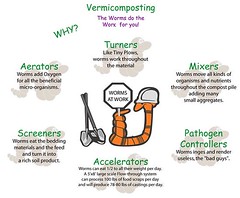 We have recently discovered the benefits of composting. I had been thinking about it for a while - every time I threw a banana peel into the garbage -there's got to be a better use for this. So, we looked more into it at the Burning River Fest. The people from The New Agrarian Center were very helpful, as was the guy from Great Lakes Brewing Company. Both are master composters.
We have recently discovered the benefits of composting. I had been thinking about it for a while - every time I threw a banana peel into the garbage -there's got to be a better use for this. So, we looked more into it at the Burning River Fest. The people from The New Agrarian Center were very helpful, as was the guy from Great Lakes Brewing Company. Both are master composters.Here's what we did - it's pretty simple. We bought a storage container (a big Rubbermaid one), some mesh screen, organic dirt, and 1,000 red worms. Drilled holes in the container - worms need to breathe air - and filled it with 6 inches of organic dirt and wet strips of newspaper and computer paper. This bedding is supposed to be moist, not dripping wet. The compost bin was set up in the basement, to avoid smell and dog curiosity, and so it could be bigger than under-the-sink. We left the light on for the first week to discourage the worms from escaping. Next, we collected all of our food scraps - banana peels, strawberry tops, bell pepper cores, onion peels, coffee grounds, etc. - and buried them under 2 inches of bedding. Now the worms take over. We're supposed to put the food in a different place each time and add new bedding every 2 months. (Don't put meat in your compost - it'll attract rodents)
What's the benefit of having a pound of red worms chewing up your food? Well, the whole process creates worm castings, which is this magical organic fertilizer that you can use in your garden. Essentially, it's natural recycling. We eat the food, feed it to the worms, they turn it into fertilizer that we'll use to grow herbs, which we'll eat in the spring. Aside from the initial set-up, it doesn't take a lot of work to maintain, and in about 4-6 months we'll have some pretty awesome soil for our garden.
Wikipedia does a good job of describing vermicomposting, or you can Blackle it. Worms Eat My Garbage is supposedly the definitive composting guide. The Village Green does outdoor composting, which is an excellent way to get rid of weeds and fallen leaves. If you do start a compost bin, don't dump your worms in the garden - red worms are not native to North America, and are an invasive species, which can threaten other earthworms.
(Here's the rest of the worm song)
Cleveland EcoVillage

The Cleveland EcoVillage is constructing Green Cottages at Pear Ave and W 58th St. The homes will have a new "green design," sell at affordable prices, and have excellent energy efficiency. Click the picture for details about their eco-design.
The cottages were designed by the Cleveland Green Building Coalition's Emerging Designers program. Heating costs will be less than $400, and electric will be about $250 per year. Green Cottages will be near the Rapid Station, churches, community gardens, schools, shops and restaurants, to encourage residents to walk more.
The EcoVillage is thriving around the concept of rebuilding a community to be pedestrian-friendly, and ecologically sound. The area is built around the Rapid transit station, and is full of community gardens and outdoor activities that residents love. Homes have superior insulation to conserve energy and save money.
Monday, August 20, 2007
Paper or Plastic: Not
Which is better - paper or plastic? It seems like paper would be the better choice because it feels more natural, so we think it will biodegrade. On the other hand, plastic takes up less room in the landfill. A lot of elements must be taken into consideration when choosing which bag to use at the grocery store.
Paper
Solution: buy a reusable bag, and reuse it. Keep your bags by the door or in the car, so you remember to take them with you. Many stores offer a discount if you reuse, and you've done a lot to reduce waste in your community. (I wonder when stores began providing bags to people, and passed the expense onto the consumer.)
This doesn't just mean plastic and paper grocery bags. Consider ziploc and brown paper lunch bags. They have an impact too. Get some reusable storage containers (Glad and Ziploc make excellent ones that are cheap and recyclable), and a cool lunchbox instead of creating waste every day. It'll save you money, and help the environment.
Paper
- Processing trees into bags requires a lot of energy
- Higher transportation costs because of size (to & from the store, to landfill)
- 1/2 of landfill space is taken up by paper
- "14 million trees in 1999 alone were cut down to manufacture the 10 million paper grocery bags used by Americans"
- Plastics are the waste products of the oil refining process (when considering the impacts of plastic bags, also keep in mind the impacts of oil extraction)
- Require less energy to produce than paper bags
- Take up less space in the landfill
- Marine life is threatened when they ingest plastic bags, which become lodged in their throat or stomach and cause starvation
- Can clog sewer pipes, which lead to standing water and health problems
Solution: buy a reusable bag, and reuse it. Keep your bags by the door or in the car, so you remember to take them with you. Many stores offer a discount if you reuse, and you've done a lot to reduce waste in your community. (I wonder when stores began providing bags to people, and passed the expense onto the consumer.)
This doesn't just mean plastic and paper grocery bags. Consider ziploc and brown paper lunch bags. They have an impact too. Get some reusable storage containers (Glad and Ziploc make excellent ones that are cheap and recyclable), and a cool lunchbox instead of creating waste every day. It'll save you money, and help the environment.
Saturday, August 18, 2007
Month in Review
I've been writing this blog for exactly one month, so I thought it would be fun to have a quick look back. I started this with the intention of sharing positive stories about the environment, ways to live a "greener" life, be healthier, and appreciate nature. I did it because I love learning new things, and to learn something good every day has been so refreshing for me. I expected to post once a week, but I've been posting every day! That's a lot of good news.
My Favorites
Things you'd like to see more of?
My Favorites
- Painted Black - I love Blackle. I'm convinced it's easier on the eyes too.
- Solar Powered Indians - anything solar is fantastic!
- Great Lakes Biodiesel - this company really sets an example
- Dammed if you do - good story
- Rain Barrels - I just love it
- Lavender oil is great, but lavender mixed with eucalyptus may be better because bees aren't attracted to eucalyptus (we haven't been stung, but I notice bees around the Lavender plant a lot)
- Green Clean for Drains
- Turn a Garbage Strike into something good
- How to get rid of Japanese Beetles
- That's certainly not all I've learned, but it's a start
Things you'd like to see more of?
Friday, August 17, 2007
Fun facts to save energy
Your car uses more gas to idle for +10 seconds than it does to turn it off and back on again. conserve: turn your car off if you're in a traffic jam or stuck at a long light.
Appliances that are "off" still use energy. reduce: Unplug large appliances (fans, toasters, heaters, laptops, etc) when you're not using them.
To disinfect kitchen sponges, microwave them for 2 minutes. reuse: Use sponges instead of paper towels for cleaning.
It takes more energy to leave lights on than to turn them on and off (popular misconception). use less: Turn the light off when you leave the room.
Running the water while you brush your teeth wastes about 5 gallons of water. (2 minutes, 2.5 gallons per minute). be efficient: Turn the water off when you brush your teeth or shave.
Appliances that are "off" still use energy. reduce: Unplug large appliances (fans, toasters, heaters, laptops, etc) when you're not using them.
To disinfect kitchen sponges, microwave them for 2 minutes. reuse: Use sponges instead of paper towels for cleaning.
It takes more energy to leave lights on than to turn them on and off (popular misconception). use less: Turn the light off when you leave the room.
Running the water while you brush your teeth wastes about 5 gallons of water. (2 minutes, 2.5 gallons per minute). be efficient: Turn the water off when you brush your teeth or shave.
Eco Living
 PowerPod has created a super ecologically-friendly house. The roof is designed with solar panels, and they bounce sun off each other to ensure maximum exposure and absorption of the sun. It funnels rain for collection and reuse, and the solar panels heat the water. So far, no carbon use.
PowerPod has created a super ecologically-friendly house. The roof is designed with solar panels, and they bounce sun off each other to ensure maximum exposure and absorption of the sun. It funnels rain for collection and reuse, and the solar panels heat the water. So far, no carbon use.These pre-fab homes have extra high ceilings with plenty of windows to let in a lot of natural light, and they're well-insulated so you don't loose a lot of heat or cool. Extra thought went into the technology of these houses, including heated floors with "a radiant heating system that circulates hot water through insulated subflooring."
More pics here! More than just pods!
- Treehugger.com
Friday Recipe - Vegan Snickerdoodles
Vegan Snickerdoodles
1 3/4 cup all-purpose flour
1/4 cup cornstarch
1 tsp baking powder
1 sick vegan margarine, softened (try Willow Run soy margarine - it's awesome)
3/4 cup sugar
1/4 cup vanilla soymilk
1 tsp vanilla extract
1/2 cup sugar
3 TBS ground cinnamon
(can also add nutmeg or alspice)
1. Preheat oven to 350F
2. Cookie Dough: Whisk together flour, cornstarch, and baking powder in bowl. Beat margarine in separate bowl with electric mixer until soft. Add sugar, and beat until fluffy. Beat in soymilk and vanilla extract 30 seconds or until smooth. Add flour mixture, and beat 30 seconds or until smooth.
3. Cinnamon Sugar: Combine sugar and cinnamon on large plate. (It makes a lot, so keep it in the fridge for the next time you make these cookies, which might be soon!)
4. Shape dough into 1-inch balls. Roll each ball in Cinnamon Sugar, and place 1/2 inches apart on prepared baking sheet. Bake 10-12 minutes, or until cookies look dry on tops and are lightly browned on bottoms. Store in airtight container.
per cookie: 49 cal, 1G protein, 1.5G total fat, 9G carb
-Vegetarian Times
Vegan foods have no cholesterol because cholesterol only comes from animal products (meat, eggs, milk, butter, cheese, etc). So, if you have high cholesterol, consider eating at least 1 vegan meal a week, and switch to soymilk and soy margarine.
1 3/4 cup all-purpose flour
1/4 cup cornstarch
1 tsp baking powder
1 sick vegan margarine, softened (try Willow Run soy margarine - it's awesome)
3/4 cup sugar
1/4 cup vanilla soymilk
1 tsp vanilla extract
1/2 cup sugar
3 TBS ground cinnamon
(can also add nutmeg or alspice)
1. Preheat oven to 350F
2. Cookie Dough: Whisk together flour, cornstarch, and baking powder in bowl. Beat margarine in separate bowl with electric mixer until soft. Add sugar, and beat until fluffy. Beat in soymilk and vanilla extract 30 seconds or until smooth. Add flour mixture, and beat 30 seconds or until smooth.
3. Cinnamon Sugar: Combine sugar and cinnamon on large plate. (It makes a lot, so keep it in the fridge for the next time you make these cookies, which might be soon!)
4. Shape dough into 1-inch balls. Roll each ball in Cinnamon Sugar, and place 1/2 inches apart on prepared baking sheet. Bake 10-12 minutes, or until cookies look dry on tops and are lightly browned on bottoms. Store in airtight container.
per cookie: 49 cal, 1G protein, 1.5G total fat, 9G carb
-Vegetarian Times
Vegan foods have no cholesterol because cholesterol only comes from animal products (meat, eggs, milk, butter, cheese, etc). So, if you have high cholesterol, consider eating at least 1 vegan meal a week, and switch to soymilk and soy margarine.
Wednesday, August 15, 2007
Burning River Fest - Best Festival Ever
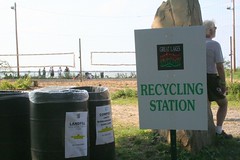 We went to the Burning River Festival on Saturday and it was the best festival ever. It was on Whiskey Island in Cleveland and the weather was perfect! There were vendors from Whole Foods, Great Lakes kegs of course, Green Energy Ohio, the Cleveland Co-op, Nature Center at Shaker Lakes, The New Agrarian Center, and so many others. Everyone was fantastic and the food was great. I missed the Great Lakes ice cream, but was treated to chocolate-covered strawberries for dessert!
We went to the Burning River Festival on Saturday and it was the best festival ever. It was on Whiskey Island in Cleveland and the weather was perfect! There were vendors from Whole Foods, Great Lakes kegs of course, Green Energy Ohio, the Cleveland Co-op, Nature Center at Shaker Lakes, The New Agrarian Center, and so many others. Everyone was fantastic and the food was great. I missed the Great Lakes ice cream, but was treated to chocolate-covered strawberries for dessert!We learned about composting, the Ohio Solar Tour coming up October, fair trade, Reduce - Reuse - Recycle, etc. More on all of those topics soon!
There was a lot of awareness-building, educating people about reducing their footprint on the planet. The whole festival was well organized with something for everyone and the atmosphere was so positive. We bought an upside down tomato plant. They grow well because no ground-based bugs eat them. I'll keep you posted.

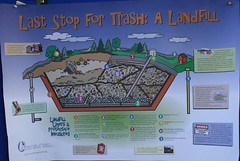
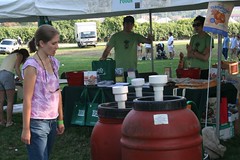
Plastic bottles
We're learning more and more about how much harm plastic bottles are causing our planet and our people every day. Not just water bottles - this includes pop, juice, and even baby bottles.
Teeth
As the popularity of bottled water rises, so do cases of tooth decay for young children. One reason is because they miss out on the fluoride that cities add to tap water.
Babies
Baby bottles contain a harmful chemical, which could be causing "prostate cancer, breast cancer. They (children) become hyperactive. They show learning impairment. It's a poster chemical for attention deficit hyperactivity disorder." Unfortunately, "The Centers for Disease Control and Prevention found BPA in the urine of 95 percent of people it tested."
Women
Plastic bottles are made with a chemical that causes reproductive harm to women's bodies. The chemical seeps from the bottle into the beverage, into the human. "That damage is a possible predictor of reproductive diseases in women, including fibroids, endometriosis, cystic ovaries and cancers."
Planet
Bottled water is a fast-growing consumer item. Last year, Americans spent $11 billion on bottled water. Unfortunately, the bottles often end up in the landfill. "Only 14 percent of water bottles are recycled."
The solution
It's nice to recycle, but we've got to Reduce and Reuse. Get a reusable water bottle and fill it at home using your tap or your water filter pitcher. This will reduce the amount of plastic that needs to be produced for your drinking convenience, and will also save you a lot of money. I couldn't fathom spending $2.50 a day for 2 bottles of water. I get mine essentially for free.
Teeth
As the popularity of bottled water rises, so do cases of tooth decay for young children. One reason is because they miss out on the fluoride that cities add to tap water.
Babies
Baby bottles contain a harmful chemical, which could be causing "prostate cancer, breast cancer. They (children) become hyperactive. They show learning impairment. It's a poster chemical for attention deficit hyperactivity disorder." Unfortunately, "The Centers for Disease Control and Prevention found BPA in the urine of 95 percent of people it tested."
Women
Plastic bottles are made with a chemical that causes reproductive harm to women's bodies. The chemical seeps from the bottle into the beverage, into the human. "That damage is a possible predictor of reproductive diseases in women, including fibroids, endometriosis, cystic ovaries and cancers."
Planet
Bottled water is a fast-growing consumer item. Last year, Americans spent $11 billion on bottled water. Unfortunately, the bottles often end up in the landfill. "Only 14 percent of water bottles are recycled."
The solution
It's nice to recycle, but we've got to Reduce and Reuse. Get a reusable water bottle and fill it at home using your tap or your water filter pitcher. This will reduce the amount of plastic that needs to be produced for your drinking convenience, and will also save you a lot of money. I couldn't fathom spending $2.50 a day for 2 bottles of water. I get mine essentially for free.
Tuesday, August 14, 2007
The Pronounceable Diet
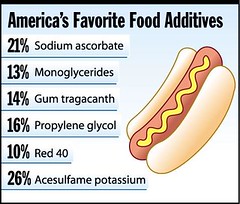 I try to follow what I call the Pronounceable Diet. That means that I try not to eat anything I can't easily pronounce, specifically, things like TBHQ (tert-Butylhydroquinone), acesulfame potassium, cochineal, mono or diglyceride, etc. The purpose is to avoid un-natural chemicals in what I eat.
I try to follow what I call the Pronounceable Diet. That means that I try not to eat anything I can't easily pronounce, specifically, things like TBHQ (tert-Butylhydroquinone), acesulfame potassium, cochineal, mono or diglyceride, etc. The purpose is to avoid un-natural chemicals in what I eat.Do you even know what's in those things without looking them up? Were you aware that cochineal is a red coloring that's made from insects? Did you know that mono and diglycerides can be made of animal products? Bad news for vegetarians. There are so many preservatives and chemicals in today's food, it's no wonder we have the health problems we do. (foreign food is excluded from The Pronounceable Diet)
Instead, I try to eat fresh food. I make nearly everything myself, and I read every label and try to buy things with fewer than 10 ingredients to get the least processed food I can. Not only does the Pronounceable Diet have fewer preservatives, fresh food tastes much better! Next time you're grocery shopping, check out the labels. It's not a pleasant surprise.
Also, don't eat things with numbers, like red #40. If there's a number sign, it shouldn't be eaten.
(The picture is from The Onion)
Green clean for drains
Here's a good way to clean your drains - as a preventative measure, or if they're clogged. We tried it last night and it really works!!
1/2 cup baking soda
1-2 cups cheap household vinegar
Pour the baking soda down the drain, followed by the vinegar. Put a plug in the drain and fill the sink with water. Wait a few minutes, then pull the plug and let the water push everything down the drain, cleaning as it goes. Awesome! -Heloise
(more on the magic of vinegar later)
1/2 cup baking soda
1-2 cups cheap household vinegar
Pour the baking soda down the drain, followed by the vinegar. Put a plug in the drain and fill the sink with water. Wait a few minutes, then pull the plug and let the water push everything down the drain, cleaning as it goes. Awesome! -Heloise
(more on the magic of vinegar later)
Monday, August 13, 2007
Thanks Betty Sutton
Congresswoman Betty Sutton introduced legislation to increase federal penalties for dog fighting. This bill has 9 co-sponsors. People care about dogs. The same legislation has been introduced in the Senate by John Kerry.
There are so many loopholes in the current dog fighting laws that people can easily slip through. Spectators are currently not open for prosecution. They are the reason dog fights happen, so they are just as bad.
Dogs are so amazing and should be treasured for the joy they bring people. I hope this legislation does a little more to deter this vicious activity.
There are so many loopholes in the current dog fighting laws that people can easily slip through. Spectators are currently not open for prosecution. They are the reason dog fights happen, so they are just as bad.
“My legislation will close these loopholes and make our federal animal welfare laws more comprehensive by ensuring that anybody who knowingly sponsors, exhibits an animal in or views a dog-fighting venture can be prosecuted to the full extent of the law. My legislation also ensures that it is illegal to buy, sell, possess, train, transport or deliver any animal specifically for the purpose of participating in a dog-fighting venture,” Sutton said.There could be tens of thousands of people involved in dog fighting in the US every year. Even in Ohio, dog fighting is a popular activity. "In March, a federal grand jury in Dayton, Ohio, indicted nine people on 45 counts for their roles in the operation of an extensive, multi-state dog-fighting ring." NE Ohio has also seen some dog fighting and cock fighting cases.
The legislation will also delete provisions in current law requiring prosecutors to prove that animals crossed state lines to fight and increase the penalty for dog fighting from a maximum three-year prison sentence to a five-year prison sentence.It should have a much longer sentence, in my opinion - participation in dog fighting unveils some serious psychological problems, and animal abuse often leads to domestic violence and other crimes.
Dogs are so amazing and should be treasured for the joy they bring people. I hope this legislation does a little more to deter this vicious activity.
What is yogurt?
I had to ask because the airport security took my yogurt when I flew to Baltimore, and I wasn't sure if it was a liquid or solid. I don't think they should have taken it for several reasons:
Poll results: 4 solid, 1 liquid
- it's so questionable
- it was sealed
- I purchased it with my breakfast at the airport.
Poll results: 4 solid, 1 liquid
No A/C for me
Here are some creative ways to stay cool without using the air conditioner. Save energy and money!
Cool ideas:
Cool ideas:
- Close blinds and windows during the day, open them at night (if it's cool out)
- Plant trees for shade
- Hang your laundry out to dry
- Utilize ceiling fans - a little air flow goes a long way
- Eat light, cool meals or grill outside
- Take a cool shower
- Make a solar oven
- Spritz yourself with some cool water (or even lavender water)
- Hang a wet sheet in an open window
- Go to the movies - it's always a/c overload at the theater
Friday, August 10, 2007
Burning River Fest Saturday
Saturday, August 11 from 1-9:30pm is the Great Lakes Brewing Company Burning River Fest.
off the Edgewater Park Exit in Cleveland
$7 adults, kids 10 & under are free
MISSIONLocation: Wendy Park at Whiskey Island
With the goal of raising awareness of environmental issues that affect our region and the Cuyahoga River ecosystem, the annual Great Lakes Burning River Fest educates families and the community on how to sustain a cleaner and healthier environment through interactive programs, music and art.
off the Edgewater Park Exit in Cleveland
$7 adults, kids 10 & under are free
Friday Recipe - Open Face Tomato-Basil Sandwiches
Open-Face Tomato-Basil Sandwiches
1 1/2 cups packed fresh basil
1 1/2 TBS grated Parmesan cheese (or soy Parmesan)
1 1/2 TBS olive oil
1 clove garlic, minced
3 TBS nonfat plain yogurt
4 English muffins, split
1 large ripe tomato, thinly sliced
Blend basil, Parmesan, olive oil in food processor or blender until well combined. Add yogurt and process until smooth. Season with salt & pepper.
Preheat broiler (toaster oven works great to save energy & keep kitchen cool!). Place muffins on baking sheet. Broil 1-2 minutes, or until slightly toasted. Spread each 1/2 with basil mixture and top with several tomato slices. Broil 1-2 minutes or until heated through.
203 Calories, 7 G protein, 7 G total fat, 29 G carb, 2 mg cholesterol, 354 mg sodium, 2 G fiber, 3 G sugars.
- Vegetarian Times
1 1/2 cups packed fresh basil
1 1/2 TBS grated Parmesan cheese (or soy Parmesan)
1 1/2 TBS olive oil
1 clove garlic, minced
3 TBS nonfat plain yogurt
4 English muffins, split
1 large ripe tomato, thinly sliced
Blend basil, Parmesan, olive oil in food processor or blender until well combined. Add yogurt and process until smooth. Season with salt & pepper.
Preheat broiler (toaster oven works great to save energy & keep kitchen cool!). Place muffins on baking sheet. Broil 1-2 minutes, or until slightly toasted. Spread each 1/2 with basil mixture and top with several tomato slices. Broil 1-2 minutes or until heated through.
203 Calories, 7 G protein, 7 G total fat, 29 G carb, 2 mg cholesterol, 354 mg sodium, 2 G fiber, 3 G sugars.
- Vegetarian Times
Thursday, August 09, 2007
Smart University Dining
As students are becoming more concerned about food quality and sustainability and nutrition issues, universities are challenged to adjust their menus to fit the needs of their student population. There are two common options for sustainable eating - organic and local. Organic food is grown without the use of chemicals and pesticides. Local food might not be organic, but has a smaller "footprint" because it travels fewer miles, and it supports the local community.
The University of California, Berkeley has committed to organic salad bars in their dining halls. The largest dining hall on campus, and the three others, have certified Organic salad bars. They have a separate prep station, and the organic veggies are not usually mixed into other meals. Most of the salad bar food comes from a 150 mile radius (sounds local to me).
Kenyon College in Ohio uses local food, including a student-run farm right on campus. Check out Kenyon's Food for Thought, a program designed to help local farmers and provide quality food at the same time.
Duke University also uses organic and locally grown food. About 20% organic and 35-70% local food can be enjoyed at Duke. Green Mountain College has a Farm and Food Project, which focuses on local foods. They have a student run farm, but like many small farms, they aren't pursuing organic certification because of costs, and limited options. Plus, they say people know how the food is grown and they trust the students. They do, however, run their greenhouses on solar and wind power, and students can "participate in our internship program with the vineyard, farm, and agricultural museum at Brunnenburg Castle in Italy." Excellent!
-University Business
The University of California, Berkeley has committed to organic salad bars in their dining halls. The largest dining hall on campus, and the three others, have certified Organic salad bars. They have a separate prep station, and the organic veggies are not usually mixed into other meals. Most of the salad bar food comes from a 150 mile radius (sounds local to me).
Kenyon College in Ohio uses local food, including a student-run farm right on campus. Check out Kenyon's Food for Thought, a program designed to help local farmers and provide quality food at the same time.
Duke University also uses organic and locally grown food. About 20% organic and 35-70% local food can be enjoyed at Duke. Green Mountain College has a Farm and Food Project, which focuses on local foods. They have a student run farm, but like many small farms, they aren't pursuing organic certification because of costs, and limited options. Plus, they say people know how the food is grown and they trust the students. They do, however, run their greenhouses on solar and wind power, and students can "participate in our internship program with the vineyard, farm, and agricultural museum at Brunnenburg Castle in Italy." Excellent!
-University Business
Tuesday, August 07, 2007
Painted Black
Many conservationists have been urging Google to transform to an all-black screen to save over 750 megawatt hours of electricity a year. Google does some excellent work in the alternative energy field, so I'm surprised they haven't jumped on the opportunity. An independent company in Australia has created a black-screen version of Google called Blackle. It's a Google powered search engine that will give you the same results as Google, but will save mega energy. Find out more.
Make http://www.blackle.com/ your homepage so that every time you launch the web, you save a little energy and remind yourself of the need to save even more.
Make http://www.blackle.com/ your homepage so that every time you launch the web, you save a little energy and remind yourself of the need to save even more.
Japanese Beetles
Many of us have the Japanese beetle plague. They're attracted to roses, and go on to consume our flowers and trees. So, how do we get rid of these nasty creatures? I've searched for some natural remedies, and this is what I came up with:
- They arrived here by boat. In Japan, they aren't a problem because they have natural predators that don't exist here.
- They're here to stay. We can't kill them all, so we have to find a way to avoid them.
- Japanese beetles are originally grubs. So, you could start by getting rid of grubs.
- "Beneficial nematodes, insect-eating nematodes, microscopic parasitic roundworms, seek out grubs in the soil." Milky spores also target grubs. - source
- Plant greenery that Japanese beetles don't like (list here)
- Don't plant things they do like (roses, Japanese Maples, etc)
- Plant a lot of garlic - Mother Earth News
(Garlic will ward off many predators, and is also great for cooking) - Make a spray out of garlic and water. Let the garlic soak, and then spray the bugs. If you need it a little stronger, add cayenne pepper
- White-flowering geraniums and zinnias are also good. Yarrow also repels bugs, and can help other plants grow
- Consider an Integrated Pest Management (IPM) program. "IPM uses biological, cultural, mechanical, and chemical controls to keep pest populations below levels that cause economic damage."
- Use traps (the bags they sell at Lowe's, etc). They attract more beetles, but most will end up in the trap. Change it frequently because they start to smell bad.
- Plant catnip near roses to repel Japanese beetles (this is my plan for next year - lots of catnip and garlic)
- More ideas and list of plants here.
Make the most of it
A garbage strike in Vancouver, Canada, has had some interesting results. Workers have been on strike for a week, and instead of complaining, residents are recycling more and many have started composting. While the city works on ending the strike, it is also encouraging people to recycle to reduce the amount of trash they accumulate.
Here are some of the things the city has suggested, but I think we could all try some of these to reduce our impact:
Here are some of the things the city has suggested, but I think we could all try some of these to reduce our impact:
an environmentalist's dream: separating wet garbage, crushing cans, adding grass clippings to the compost, letting grass grow longer (and setting your mower to mulch instead of throwing grass away), and put fruit and vegetable waste in the compost.Will these waste-reducing residents hamper the striker's leverage? Possibly. If people use less, reduce their garbage, and learn to recycle and compost, the garbage collectors may not be as critical as they thought. The garbage strike won't be fun long-term, but it may get people to think about their consumption, and where it all goes.
Monday, August 06, 2007
The dangers of coal
Here's another great reason for the country to move away from its dependence on coal. A coal mine in Utah has collapsed after a 4.0 earthquake, leaving 6 men trapped inside. This mine is southeast of Salt Lake City, in the desert of Utah - a great place to generate solar power. Coal-powered electricity is not only dangerous to the planet, but also to humans, in so many ways.
I hope those men get out alive.
I hope those men get out alive.
Sunday, August 05, 2007
Southern Ohio
 I graduated from Ohio University, and I loved Athens so much that my husband and I try to go down there every year for the Athens International Film Festival. We didn't make it this spring, so we went down for 2 days this week. We brought our dog, Kimse, and stayed in a cabin on Lake Hope. It was beautiful! We packed our food, and grilled every night. I enjoyed a Burrito Buggy burrito for lunch. Yum! Athens is such a fun town, and it's always interesting to drive the back roads and wonder about the people who live in Southern Ohio. Here are a few pictures of our trip.
I graduated from Ohio University, and I loved Athens so much that my husband and I try to go down there every year for the Athens International Film Festival. We didn't make it this spring, so we went down for 2 days this week. We brought our dog, Kimse, and stayed in a cabin on Lake Hope. It was beautiful! We packed our food, and grilled every night. I enjoyed a Burrito Buggy burrito for lunch. Yum! Athens is such a fun town, and it's always interesting to drive the back roads and wonder about the people who live in Southern Ohio. Here are a few pictures of our trip.On Friday, we took Kimse and rented a rowboat to paddle around Lake Hope. Kimse, of course, had to fall in. She's no fan of water, but she composed herself quite well after the experience.


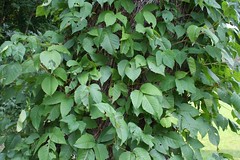

What a wonderful trip. We relaxed and listened to the bugs, did a little sightseeing, and spent a lot of time in nature. It was very peaceful.
Wednesday, August 01, 2007
Sweet Kitty Litter
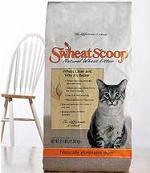 A while back, I was reading Peppermint Lisa's blog and she wrote about a new kind of kitty litter called Swheat Scoop. It's made of wheat, ground down to the size of regular kitty litter.
A while back, I was reading Peppermint Lisa's blog and she wrote about a new kind of kitty litter called Swheat Scoop. It's made of wheat, ground down to the size of regular kitty litter.The clay kind was nice at first, but the cats kicked up a lot of unhealthy dust, and a lot of plastic bags were used to remove the mess. Also, the clay kind is mined out of the earth, which is not so nice. This new wheat litter comes from a renewable resource, is biodegradable, and can be flushed down the toilet. It also smells better - more natural. You also don't need to put a plastic bag in the garbage every day - just flush it down the toilet.
One word of caution: my cat Lemon thought it was food, because his is sometimes given buckwheat pancake mix. To avoid that, sprinkle the old litter on top for a few days, but be sure to throw that out - don't flush it until it's pure Swheat Scoop.
be efficient: Wash your car on the grass.
Subscribe to:
Comments (Atom)

